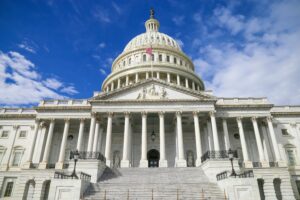Capitol Compass: November 2024 Edition
Written by Kellen PA staff
Former President Donald Trump has handily won the election over Vice President Kamala Harris. While the election has been called, states will continue counting votes, conduct any necessary recounts, and certify election results between now and January 6, 2025, when Congress will convene to certify Donald Trump as the next President. On December 17, state electors will meet to officially cast votes for President and Vice President.
Voters primarily pointed to the economy and inflation as key areas of concern. They also identified the state of democracy, as well as abortion and immigration. More generally, voters expressed concern that the country is headed in the wrong direction.
As of the time of writing, the House has not been determined as several races have not been called and neither party has reached the required 218 seats for a majority. Republicans previously held an eight-seat majority (220 Republicans and 212 Democrats), with three vacancies in districts previously represented by member who have either resigned or died.
In the Senate, there were 34 seats were up for re-election, including a special election in Nebraska. Republicans have won control of the Senate, flipping several seats from Democratic control. In Montana, incumbent Sen. Jon Tester (D-MT) lost to Republican challenger Tim Sheehy (R). Sen. Sherrod Brown (D-OH) of Ohio lost his seat to Republican challenger Bernie Moreno (R). In Pennsylvania, challenger Dave McCormick (R) beat incumbent Senator Bob Casey (D-PA). In Nevada, incumbent Sen. Jacky Rosen (D-NV) is projected to win the race against Sam Brown (R), but some outlets have refrained from calling it.
Arizona is a potential bright spot for Democrats. The race between Rep. Ruben Gallego (D-AZ) and Kari Lake (R) remains too close to call, but Gallego has a slight lead. This election is for the vacancy left by Sen. Kyrsten Sinema (I-AZ) who is retiring.
House and Senate Republicans plan to hold secret ballot votes next Wednesday, Nov. 13, to nominate their leadership teams for each chamber. House Democrats will hold their leadership elections on Nov. 19, while the Senate Democrats likely will vote in early December.
Currently, it is estimated that around 158 million Americans cast ballots, representing a voter turnout of about 65 percent. This figure is down from the 67 percent voter turnout witnessed in 2020. Despite the overall decrease, many states broke previous early voting turnout records and increased their turnout compared to 2020.
Donald Trump’s decisive victory is partially owed to his successful campaign strategy of peeling away small numbers of voters in key demographics from Harris and the Democrats. For example, Trump’s support from Latino voters grew from 35 percent in 2020 to 42 percent in 2024. Harris received only 56 percent of Latino votes compared to 63 percent for Biden in 2020. Trump also doubled the support he received support from Black voters from 8 percent in 2020 to 16 percent in 2024. In comparison, 83 percent of Black voters supported Kamala Harris, down from the 91 percent who supported Joe Biden in 2020.
Overall, Harris failed to turn-out the vote. Harris received 1.4 million fewer votes than her predecessor, Joe Biden, did, while Trump received 1.1 million more than he did in 2020. Harris also failed to improve her numbers in swing states Arizona, Georgia, Michigan, Nevada, North Carolina, Pennsylvania and Wisconsin while Trump managed to gain more votes.
A key ballot initiative in multiple states – open primaries and a ranked choice general election –failed to pass. Open, or all-party, primaries allow voters to cast ballots in a primary regardless of their political affiliation, unlike closed primaries which require voters to register with a party in primary for that party’s candidates. Ranked choice voting, also known as instant runoff voting, lets voters rank candidates in order of preference, and the top two or three candidates advance into another. These measures were often (but not always) combined into one ballot measure.
Supporters have argued that the measures benefit voters and eliminate partisanship. However, officials on both sides of the aisle opposed them, arguing that they confuse voters and benefit the other party. Opposition from elected officials is not a surprise, as the measures can hurt incumbents by allowing more opportunities for challengers to beat them. Ultimately, Voters shot down similar efforts in Arizona, Colorado, Idaho, Montana, Nevada, Oregon and South Dakota. A combine measure passed in Washington D.C. As a result, most voters are unlikely to see any changes to the electoral process in the next election.


